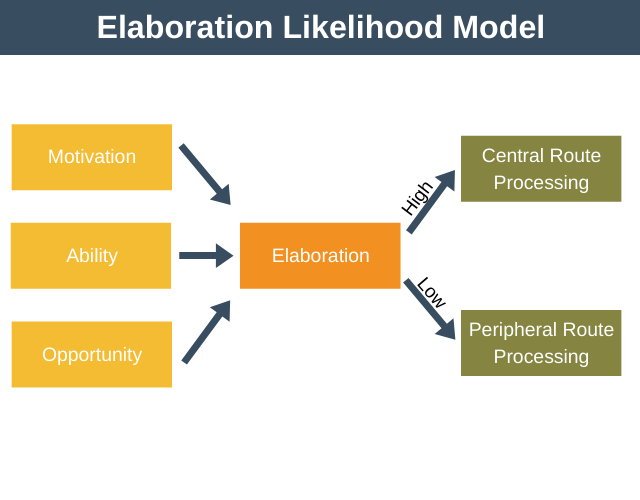
Week 12: Elaboration Likelihood Model
Elaboration Likelihood Model
Richard E. Petty and John T. Cacioppo made a theory based on the concept of persuasion in 1980 known as Elaboration Likelihood Model of Persuasion. This model is based on the idea that persuasion level of a message can affect the desired effect of the message. A persuasive message will most likely change the attitude of the message recipient. Attitude change occurs even when the intention of message sending is not to change the attitude of the recipient.
The Elaboration Likelihood Model claims that there are two paths to persuasion: the central path and the peripheral path. The central path is most appropriately used when the receiver is motivated to think about the message and has the ability to think about the message. If the person cares about the issue and has access to the message with a minimum of distraction, then that person will elaborate on the message. Lasting persuasion is likely if the receiver thinks, or rehearses, favorable thoughts about the message. A boomerang effect (moving away from the advocated position) is likely to occur if the subject rehearses unfavorable thoughts about the message. If the message is ambiguous but pro-attitudinal (in line with the receiver's attitudes) then persuasion is likely. If the message is ambiguous but counter-attitudinal then a boomerang effect is likely.
If the message is ambiguous but attitudinally neutral (with respect to the receiver) or if the receiver is unable or not motivated to listen to the message then the receiver will look for a peripheral cue. Peripheral cues include such communication strategies as trying to associate the advocated position with things the receiver already thinks postively towards (e.g., food, money, sex), using an expert appeal, and attempting a contrast effect where the advocated position is presented after several other positions, which the receiver despises, have been presented. If the peripheral cue association is accepted then there may be a temporary attitude change and possibly future elaboration. If the peripheral cue association is not accepted, or if it is not present, then the person retains the attitude intially held.
If the receiver is motivated and able to elaborate on the message and if there are compelling arguments to use, then the central route to persuasion should be used. If the receiver is unlikely to elaborate the message, or if the available arguments are weak, then the peripheral route to persuasion should be used.
Two Routes of Persuasion
Attitude change occurs in two ways according to the scholars who proposed the model. They are known as the two routes of persuasion. The two routes apply to and differ according to all the groups of people mentioned above. The two routes show that messages take one of the two routes during the process of sending and receiving messages.
- Central Route Persuasion
Central route of persuasion tells that if a person gets to think about a message received for a longer duration of time, then the person has a greater chance of being persuaded. The process of thinking for a longer duration is known as elaboration.
For this, people need motivation. If the persuasion level of the message is strong, he/she gets persuaded to change their attitude or behavior.
There are certain features that message must have to be central route persuasive. They are:
- Persuasive communication
It has to be one-sided and not neutral. There must be some benefits to any of the people involved, either sender or receiver. For example, an advertisement. - Motivation to process
Relevant messages or deep relation with the topic of the message motivate people to change their attitude, which is also known as high involvement. They must really be gripped by the information and interested in it. - Ability to process
When there are distractions, complications and noise, people do not process the information they get. They might be hearing but not listening. This might cripple the persuasive power of the message. - Nature of arguments
If the message is strong, well constructed, convincing or creative, people will get the message better and change their attitude accordingly. This makes the recipient adopt the attitude changes.
2.Peripheral Route Persuasion
If a message given by a person does not elaborate on the meaning of the message, the message can still be persuasive even if the content is not persuasive enough. It can be due to direct relationship of the person with the content, familiarity with the topic, positive attitude towards the sender, positive thoughts (sex, money), etc. This kind of persuasion or attitude change might not last for a long time. This also happens if the recipient is unable to process the message or if the content is weak.
For example, if an energy drink is advertised by your favorite footballer, then you would like to buy that brand product rather than others.
Six features of peripheral route persuasion according to Robert Cialdini are:
- Reciprocation (past experience)
- Consistency (reliability since past)
- Social proof (Peer pressure)
- Liking (Attractiveness, personality)
- Authority (Power, expertise)
- Scarcity (Limited duration)
If by any of the two methods of persuasion, a person is affected, the person might have temporary or permanent attitude change. The effect lasts longer if the same message is repeated again and again.



